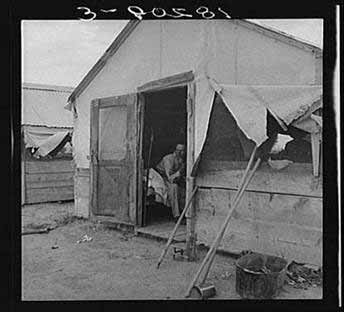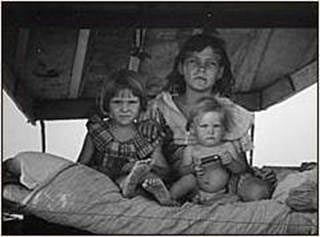Teacher Resources
The Journalism Cycle: Personalizing the Harvest Gypsies
by Traci Mumm, Chapparal High School, Parker, Colorado, 2007
In journalism classes, students have difficulty with the entire interview process. They struggle with attending to details, determining the information they will need, focusing the story and recording accurately. My class will use Steinbeck’s Harvest Gypsies to complete the journalism cycle from story inception through final draft.
Requirements
- Copy Harvest Gypsies by John Steinbeck
- Pictures of Dust Bowl migrants
Lesson Sequence
Day One
Harvest Gypsies Day
- As a class, we will read Chapter 1 of Harvest Gypsies aloud. Students will pay particular attention to details that personalize and individualize the Dust Bowl Migrant and his plight.
- As a class, we will examine the text looking for the personalizing details. They will keep track of the details we find in their notebooks.
Day Two
Picture Day
- Today, we will look at pictures of Dust Bowl migrants. We will talk about the details in the pictures that match the details that came from our reading. Again, they will record their details in their notebooks.
Day Three
Classroom Discussion Day
- Class discussion day. Today, we talk about the stories the details tell us. As journalists, what are the stories here? What do these people have to tell us? What do their faces say? What can you determine from Steinbeck’s discussion of them and their plight? What are the important details? What are the different angles we could take? What are the ethical issues we might face if we decided to write these stories? What is interesting?
- For homework tonight, they need to write a reflection of this experience so far. They should address what has intrigued them, what they know and what they still need to discover. I want them to really think about the stories that are there to tell.
- The reflection should also include a person who has emerged for them. They don’t necessarily have to pick a person who they’ve seen; they can create an aggregate person from the many details from the last two days.
Day Four
Interview Day
- We begin today with an analysis of how to conduct an interview. The class will, as a whole, create a personality from their Dust Bowl research and then decide as a class, what information we need to get from this character to tell our story. I will keep track of the information on the board.
- We will also have the “oral interview” discussion about how to ask questions. I will include in this discussion a warning about coming to the interview ill-prepared and maintaining too much control over where the interview goes. We will also discuss the destructive effect yes/no questions have on an interviews and how to keep the interview going by being sensitive to uptake opportunities.
- For Homework, they should record the information they’re looking for. This work should include a list of questions they want to ask.
Day Five
Interview Day Continued
- Today, I become the migrant we created yesterday. The class will spend the period asking me questions (as the migrant) and recording the answers. For any question they can’t ask because they just can’t get it worked in, they can make up an answer, as long as this answer stays true to the original interview. These notes will be turned in as part of the final project.
Day Six
Writing the Story
- Today, they become journalists and write their story. They must use quotes they recorded on the interview days, but they can make up other quotes when they are necessary. Their story should written as if it were going to be a part of a Sunday Feature spread of the Dust Bowl Migration. Their audience is someone reading the paper in the 1930’s during the migration and Great Depression.
Students will turn in:
- Notes from days one and two (Harvest Gypsies and Picture Day).
- Questions and recorded answers from the Interview Days
- Final, edited draft of their Migrant feature story.
 
 
 
 
  
|

